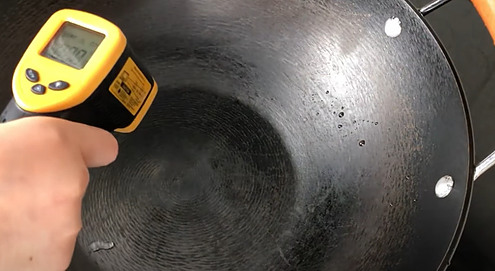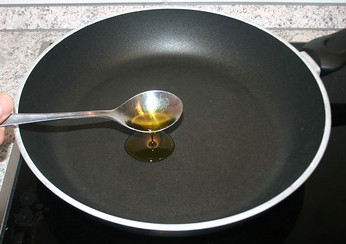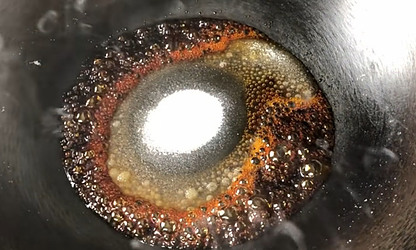Stainless steel pan is a popular choice as a cooking pan because of its durability, non-toxic, good conductivity, easy to clean (if no food sticking), light weight, polished and shining.
Normally people use stainless steel pan for frying, sautéing, and searing, with cooking oil as a common ingredient.
But when using a stainless steel pan, the oil may burn after being heated.
Here I am going to discuss why oil burns on stainless steel pan.
I hope this article is going to help you reduce the fire risk when cooking with a stainless steel pan.
Table of Contents
Why does oil burn on stainless steel pan?
The overheated stainless steel pan causes the cooking oil temperature to rise until fire point and burning occur. Incorrect methods of measuring the pan temperature may cause the pan to overheat. Another reason could be the hot spots on the pan which are caused by low quality stainless steel pan and uneven heat distribution from heat source.
The cooking oil is heated by an overheated stainless steel pan until it reaches a fire point.
Stainless steel pan heats up quickly because of its high conductivity.
When the stainless steel pan overheats, the cooking oil will start to burn when its temperature rises to fire point.
What happens to the cooking oil when it is heated and why does it burn?
When cooking oil heated to smoke point, it will start to break down and produce smoke.
The food will have an unpleasant flavor and odor because of the damaged oil.
Further heating the cooking oil, it will reach its flash point.
It is a temperature point where the cooking oil generates enough vapor which is sufficient for ignition when exposed to a fire source like spark or flame.
Then finally cooking oil heated until achieves the fire point, a temperature point where cooking oil generates enough vapor to burn continuously after being ignited,
The fire point, a temperature which is able to sustain the oil for combustion.
When the stainless steel pan is heated until the cooking oil reaches the fire point temperature, then oil will start to catch fire.
Use the incorrect method of measuring the pan temperature.
If the method of measuring the pan temperature is incorrect, you may make a mistake of estimating the pan temperature wrongly.
End up adding oil into an overheated pan and burning occurs.
How could this happen?
There are some possibilities of why you make mistakes in measuring pan temperature.
Some people are using a temperature gun (infrared temperature gun) for measuring the pan temperature.
Temperature gun measures a surface temperature by detecting the infrared radiation emitted by its surface.
But this would be a problem for measuring a stainless steel pan surface which is shiny and reflective.
When a temperature gun is trying to measure the stainless steel pan surface, the infrared radiation from the surrounding environment will emit to the stainless steel surface and then reflected to the temperature gun detector.
This can disturb the temperature measurement and cause the temperature gun to pick up the ambient temperature rather than the temperature of the stainless pan surface.
On top of that, the smooth and non-absorbent stainless steel surface has low emissivity, meaning it does not emit much infrared radiation, making the temperature gun more difficult in measuring the actual pan temperature.
Another pan temperature measurement method may also cause wrong judgment of temperature.
The method is using water splash on the hot stainless steel pan.
When water splashes on the stainless pan, the water evaporates immediately, meaning the pan temperature is above the boiling point of water of around 100°C (212°F), .
When the water droplets start to “rolling” or “bouncing”, achieving Leidenfrost point, the pan temperature is approximately 193°C (379°F) or above.
The bad about this temperature testing method is it can only test the temperature 193°C or above.
If the water droplets start to roll and bounce, it means the pan temperature is 193°C or above.
And the pan could be 400°C as well.
So the stainless steel pan may overheat even though the water droplets roll and bounce on the pan.
This is the reason for oil burning because you add oil into an overheated pan by judging that water rolls and bounces on a 193°C pan, by right it still has the possibility of higher than 193°C.
Small amount of cooking oil is added into the heated pan.
Small amount of oil added to the pre-heated stainless steel pan also could lead to fire burning.
A smaller volume of oil would heat up faster compared to a large volume of oil.
Furthermore, small volume oil has a higher surface-to-volume ratio, meaning it has a higher chance to absorb more heat and cause low volume oil temperature to increase faster.
On the other hand, a larger volume of oil has a lower surface-to-volume ratio, the oil would heat up slower compared to a small volume of oil.
The larger volume of oil has a bigger capacity to absorb more heat and can help to regulate the pan temperature, keeping it from becoming too hot.
The forming of hot spots on the pan.
The forming of hot spots on the stainless steel pan can cause oil burning as well.
Hot spot refers to heat concentration at a small specific area on the stainless steel pan with very high temperature.
Hot spots form because of uneven distribution of heat in the pan material when it is heated.
This can happen due to differences in the thickness of the stainless steel pan, variation in the heating capacity across the area of the heat sources (gas stoves, electric or induction stovetops ), or deformations (dented, warping, or manufacturing defect) in the surface of the cookware.
Final Thought
The philosophy of preventing oil burning on stainless steel pan is to avoid oil temperature rise to its fire point.
Therefore it is important to know the smoke point, flash point, and fire point of the cooking oil you use.
Different types of cooking have different smoke points, flash points, fire points.
Then practice the correct method of measuring the pan temperature so that you don’t put cooking oil into an overheated pan.



